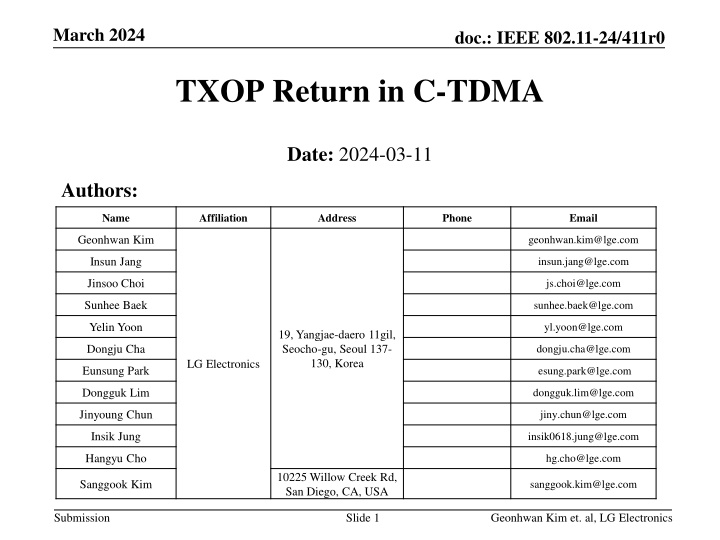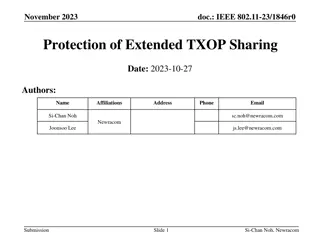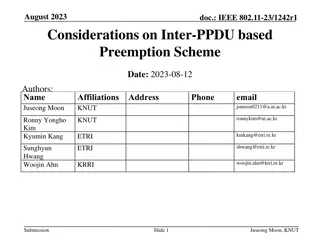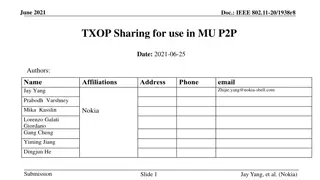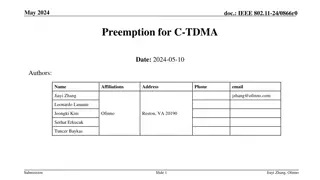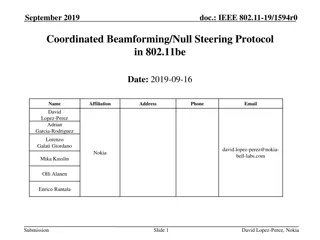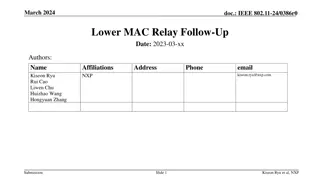IEEE 802.11-24/411r0 TXOP Return in C-TDMA
This document discusses the TXOP return mechanism in C-TDMA operation for IEEE 802.11 networks. It explores the importance of timely TXOP return for efficient utilization of medium and proposes considerations for implementing TXOP return in C-TDMA. Various TXOP return scenarios and frame types are analyzed to enhance shared AP and neighboring STAs' performance in accessing the channel.
Download Presentation

Please find below an Image/Link to download the presentation.
The content on the website is provided AS IS for your information and personal use only. It may not be sold, licensed, or shared on other websites without obtaining consent from the author.If you encounter any issues during the download, it is possible that the publisher has removed the file from their server.
You are allowed to download the files provided on this website for personal or commercial use, subject to the condition that they are used lawfully. All files are the property of their respective owners.
The content on the website is provided AS IS for your information and personal use only. It may not be sold, licensed, or shared on other websites without obtaining consent from the author.
E N D
Presentation Transcript
March 2024 doc.: IEEE 802.11-24/411r0 TXOP Return in C-TDMA Date: 2024-03-11 Authors: Name Affiliation Address Phone Email Geonhwan Kim geonhwan.kim@lge.com Insun Jang insun.jang@lge.com Jinsoo Choi js.choi@lge.com Sunhee Baek sunhee.baek@lge.com Yelin Yoon yl.yoon@lge.com 19, Yangjae-daero 11gil, Seocho-gu, Seoul 137- 130, Korea Dongju Cha dongju.cha@lge.com LG Electronics Eunsung Park esung.park@lge.com Dongguk Lim dongguk.lim@lge.com Jinyoung Chun jiny.chun@lge.com Insik Jung insik0618.jung@lge.com Hangyu Cho hg.cho@lge.com 10225 Willow Creek Rd, San Diego, CA, USA Sanggook Kim sanggook.kim@lge.com Submission Slide 1 Geonhwan Kim et. al, LG Electronics
March 2024 doc.: IEEE 802.11-24/411r0 Introduction C-TDMA mechanism may involve a TXOP return procedure to reclaim time allocated to the shared AP. Because the shared AP may only use less time than the time allocated by the sharing AP. TXOP return is helpful to the sharing AP and neighboring STAs of the shared AP; Medium utilization: The earlier the allocated time is returned, the more the sharing AP can use the remaining TXOP and the earlier the neighboring STAs can perform a channel access. This contribution presents some considerations for TXOP return can performed in C-TDMA operation. Submission Slide 2 Geonhwan Kim et. al, LG Electronics
March 2024 doc.: IEEE 802.11-24/411r0 Recap: TXOP Return in TXS TXOP return in EHT s TXS (Triggered TXOP Sharing) is as follows: TXS mode = 1 (UL transmission): When UL PPDU is not received during PIFS from the scheduled STA within an allocated time. In C-TDMA, this return method is not available because individual frame exchanges are only performed within the shared AP s BSS. i.e., C-TDMA operation is not intended for AP-to-AP frame exchange. TXS mode = 2 (UL & P2P transmission): When a QoS Null/Data frame containing a CAS Control field indicating a TXOP return is received from the scheduled STA. QoS Null/Data frames containing CAS Control field (RDG/More PPDU = 0) can only be exchanged with associated STAs that have the corresponding capability [1]. Therefore, a TXOP return method between APs for C-TDMA operation needs to be designed. Submission Slide 3 Geonhwan Kim et. al, LG Electronics
March 2024 doc.: IEEE 802.11-24/411r0 TXOP Return frame in C-TDMA The shared AP that has completed FE within its BSS may transmit a TXOP return frame to indicate the end of the allocated time. The sharing AP can then start its FE in xIFS after receiving the TXOP return frame. The frames below may be used for TXOP return purposes especially in C-TDMA. CF-End frame [1-3] Management frame using A-Control field Action frame (e.g., newly defined for Multi-AP coordination or C-TDMA or TXOP return) MU-RTS TXS TF (shared AP sharing AP) & CTS frame 1. CF-End: OBSS STAs adjacent to a shared AP receive this frame and reset their basic NAV. Immediately invoke the backoff procedure to obtain the medium. 2. Others: Can be transmitted only to the sharing AP without NAV reset of OBSS STAs. Assists sharing AP to reclaim remaining TXOP. Submission Slide 4 Geonhwan Kim et. al, LG Electronics
March 2024 doc.: IEEE 802.11-24/411r0 Necessity of TXOP Return frame transmission However, discussion is needed as to whether the time-allocated shared AP should always transmit the TXOP return frame. Case 1) When allocated time is fully utilized (no TXOP return frame). The shared AP utilizes the allocated time as much as possible and does not transmit a separate TXOP return frame. The sharing AP can initiate FE after xIFS when the allocated time expires. Case 2) In C-TDMA, a TXOP return frame should be transmitted. This TXOP return frame is responsible for signaling the sharing AP. However, situations may arise where the sharing AP does not receive this frame. The sharing AP may wait until the allocated time expires. A forced TXOP return method by the sharing AP (when no PPDU transmission is detected from the shared AP for a certain period of time) can be considered. Submission Slide 5 Geonhwan Kim et. al, LG Electronics
March 2024 doc.: IEEE 802.11-24/411r0 CCA after TXOP Return Basically, the sharing AP owns the TXOP but does not exchange frames during the time allocated to the shared AP. If an OBSS STA that was hidden from the shared AP and was in a doze state wakes up at the allocated time, it may occupy part or all of the sharing AP s BW. Also, if the sharing AP is not protected by NAV during the allocated time [4], adjacent STAs (e.g., whose NAVTimeout has expired) can access the channel. Therefore, we need to determine the CCA interval and bandwidth that the sharing AP shall perform. Submission Slide 6 Geonhwan Kim et. al, LG Electronics
March 2024 doc.: IEEE 802.11-24/411r0 CCA interval & PPDU bandwidth Keeping in mind that STAs can occupy the medium for an allocated time (in slide 6), the interval of CCA performed by the sharing AP have to be determined. SIFS interval may cause conflicts with STAs that can occupy the medium. EHT AP uses the PIFS interval when returning a TXOP from a non-AP STA. The PIFS interval can also be used in TXOP return in C-TDMA. EDCA backoff may be invoked when the primary channel or a channels that overlap with a shared AP containing the primary channel is busy. Basically, when performing TXS, the AP's PPDU bandwidth can become smaller. Submission Slide 7 Geonhwan Kim et. al, LG Electronics
March 2024 doc.: IEEE 802.11-24/411r0 CCA interval & PPDU bandwidth Therefore, the bandwidth to perform a CCA needs to be determined. Option 1) CH_BW of the initial frame in the TXOP of the sharing AP Option 2) CH_BW of MU-RTS TXS TF (preceding PPDU) Option 3) BSS operating channel width of the sharing AP (Max BW) Performs CCA based on one of Options 1) to 3) and uses idle CHs to deliver PPDUs during the remaining TXOP. Depending on the scenario, options 1) and 3) may have a larger BW compared to 2). Submission Slide 8 Geonhwan Kim et. al, LG Electronics
March 2024 doc.: IEEE 802.11-24/411r0 Summary In this contribution, we discussed about a TXOP return in C-TDMA. Since the TXOP return in EHT s TXS cannot be used as it is, TXOP return for C-TDMA (or between APs) should be designed. We present discussion points to ensure that TXOP return is successful. TXOP return frame Necessity of TXOP return frame transmission CCA interval & bandwidth after TXOP return Submission Slide 9 Geonhwan Kim et. al, LG Electronics
March 2024 doc.: IEEE 802.11-24/411r0 References [1] 23/0739r1, Follow-up on Coordinated TDMA (C-TDMA) [2] 23/1327r0, Considerations on Return TXOP between multiple APs [3] 23/1895r2, C-TDMA frame sequence [4] 24/0227r0, TXOP Protection in C-TDMA Submission Slide 10 Geonhwan Kim et. al, LG Electronics
March 2024 doc.: IEEE 802.11-24/411r0 Straw Poll 1 Do you agree to add the following text to the TGbn SFD? A mechanism shall be defined by which the shared AP returns the remaining portion of its allocated time to the sharing AP. Submission Slide 11 Geonhwan Kim et. al, LG Electronics
